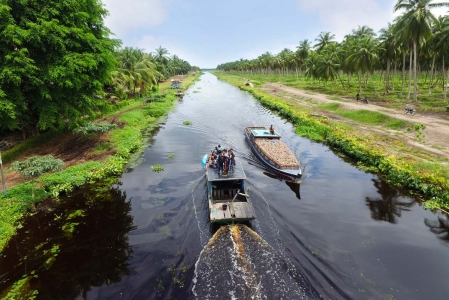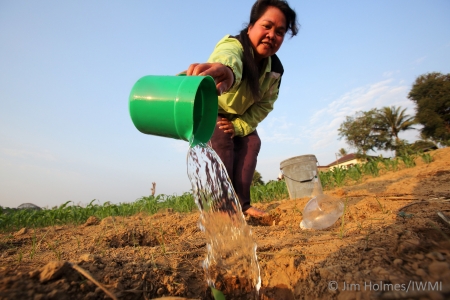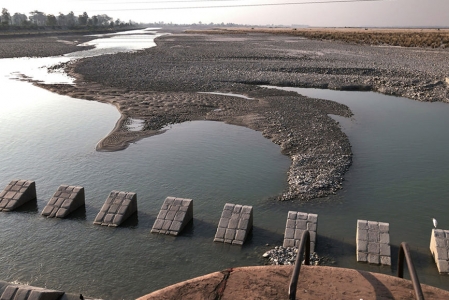Extreme weather events are not new to the Asia Pacific. Every year, major swaths of the region are visited by seasonal monsoons that have the potential to bring floods and destroy property, crops, and livelihoods. At other times of the year, water resources are so scarce that agricultural activity grinds to a halt.
These variations in weather patterns have been exacerbated by the effects of climate change as well as by land use change, urbanization, and degradation of ecosystems that act as climatic buffer zones. The region is the most disaster prone globally, with over 80% of the people affected by disasters being from the region, and with over 6,543 regional fatalities from major disasters in 2017 alone. In South Asia, for example, about 750 million people were affected by floods and droughts between 2000 and 2010. In August 2017, over 40 million people in Bangladesh, India and Nepal were affected by intense monsoonal rains. Farmers, rural communities and the urban poor are the worst affected by these severe weather events.
Managing disaster to mitigate risk
As the number and frequency of natural disasters rise steadily year by year, their impact is being felt more acutely. If disaster risk is not properly managed, especially for the most vulnerable parts of society, it will become more and more difficult to recover from the damage caused by these hazards.
While traditional risk management programs focus on responding or reacting to disasters, it’s critical to plan in advance in order to mitigate the effect of catastrophic events before they happen. As such, the United Nations International Strategy for Disaster Reduction (UNISDR) is hosting the Asian Ministerial Conference on Disaster Risk Reduction from 3-6 July in Ulaanbaatar to strengthen governance, improve risk sensitive investment, and develop better early warning for the region.
The International Water Management Institute (IWMI) will be there to present on some of the Disaster Risk Management (DRM) interventions that it has developed as part of the CGIAR Research Programs on Water, Land and Ecosystems (WLE) and on Climate Change, Agriculture and Food Security (CCAFS). Below are six examples of these DRM interventions that could help improve the resilience of the Asia Pacific to disasters.
1) Safeguarding poor farmers with flood insurance
Index-Based Flood Insurance (IBFI) is designed to safeguard farmers in locations at high risk for flooding. IBFI combines hydrological modelling and 10m-resolution satellite images with rainfall data for particular catchments, showing how rainwater will travel and collect. If a trigger level is reached, satellite images are used to verify the depth and duration of the flood, thereby allowing insurance companies to accurately identify what areas were affected and which farmers are eligible for compensation.
A pilot project was established in Bihar, India, where 76% of the population lives under the recurring threat of floods. The Agriculture Insurance Company of India agreed to insure farmers against damaging floods for the 2017 monsoon season, on the basis of scientific data showing the depth and duration of floodwaters in paddy fields. Fourteen farmers, who suffered the total loss of their crops during the monsoon, received full compensation of INR 20,000 per hectare. Others received between INR 7,000 and INR 14,000, according to the extent of their losses. IWMI is currently in talks with the World Bank to work on scaling up the plan across eastern India.
2) Monitoring and managing droughts at regional level
Drought affects more people than any other physical hazard, having claimed over 11 million lives since 1900. Launched in 2017, the South Asia Drought Monitoring System (DMS) is an international collaboration that seeks to improve resilience and responses to drought. Every eight days, IWMI produces detailed drought severity maps using satellite data, showing how drought is affecting agriculture across Afghanistan, Bangladesh, Bhutan, Maldives, Nepal, India, Pakistan and Sri Lanka. At 500-meter spatial resolution, the maps are more detailed than other commonly available drought products.
At the DMS’s core lies an Index-based Drought Severity Index (IDSI). This IDSI uses satellite data on vegetation cover, temperature and soil moisture levels from the year 2000 onwards in order to classify areas into seven categories ranging from Healthy (vegetation) to Extreme (drought). IWMI researchers tested the system’s ability to accurately represent drought of varying intensities by examining public records of past crop yield losses and making extensive field visits.
3) Using satellite data on soil moisture to help forecast droughts
As an extension to the South Asia DMS, IWMI worked with the Indian Council of Agricultural Research (ICAR) to develop a drought early-warning system for six districts. Agricultural droughts arise when there is a lack of water in the soil around the root zone of crop plants. Radar backscatter measurements, gathered by a sensor on board the EUMETSAT MetOp satellite, provide a means to accurately estimate water deficit in the soil. Working in collaboration with the Vienna University of Technology and the Indian Institute of Tropical Meteorology, IWMI used this data to develop a Soil Water Anomaly Drought Index (SWADI).
Historically, ICAR would issue instructions regarding forecast droughts to an entire district, regardless of differing situations across the area. The new system shows exactly where dry conditions are likely to worsen, so ICAR can inform the relevant agricultural departments. These departments can then brief farmer associations and communities on what drought-tolerant crops to sow, where to obtain seeds, and appropriate soil-water conservation methods. The knowledge produced by SWADI is also useful for the national government, as it can help estimate any long-term production losses and take appropriate action to counteract these potential deficits.
4) Flood forecasting using satellite-derived river data
The Niger-Benue River basin in Africa is regularly devastated by severe floods but has limited hydrological data and networks on which to build flood-forecasting systems. IWMI undertook studies to assess the potential for using radar altimetry – which can measure the height of water surfaces – to fill this data gap. When the scientists compared estimates derived from the satellite data with measurements on the ground, they not only found a good correlation, but also that of estimates of up-stream water level could be used to accurately predict downstream discharge occurring five days later. The study demonstrated the potential for satellite altimetry data to be used in building robust flood-forecasting systems across transboundary river basins.
5) Satellite maps guide emergency response to flooding in Asia
Led by the Asia-Pacific Regional Space Agency Forum (APRSAF), Sentinel Asia is an initiative through which organizations in the region use remote sensing and web-GIS technologies to assist with disaster management. On several occasions, IWMI has activated its emergency response disaster charter, and worked in partnership with Sentinel Asia to assist with emergency response mapping. In August 2017, incessant rains caused severe flooding in the Indian states of Bihar and Assam, and in southern Nepal, affecting two million people. IWMI used European Space Agency Sentinel-1 cloud-penetrating satellite data to develop high-resolution rapid response maps. These helped to guide relief efforts by enabling officials to locate vulnerable populations and to estimate the level of damage to crops early on. In the past, IWMI has provided similar assistance in other parts of India and Sri Lanka.
6) Increasing irrigation water while reducing flooding
IWMI is currently researching a completely new way to increase the amount of groundwater available to farmers while simultaneously reducing the impacts of floods. The process, described as Underground Taming of Floods for Irrigation (UTFI), involves increasing the volume of water that infiltrates into underground aquifers during the wet season and extracting it for irrigating crops during the dry season. A study of Thailand’s Chao Phraya river basin has indicated that 270,000 additional hectares of land could be irrigated and that 25% of monsoon rainfall runoff could be stored in aquifers. This could potentially save billions of dollars in avoided damage from floods and droughts. A UTFI pilot was implemented in Rampur, Uttar Pradesh State in India, and IWMI is talking with the government to explore the possibility of expanding UTFI at scale across the Ganges river basin.













